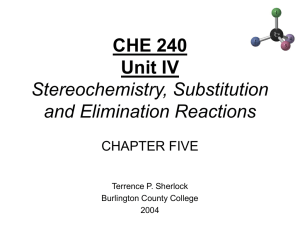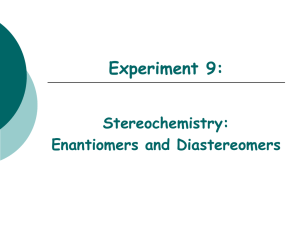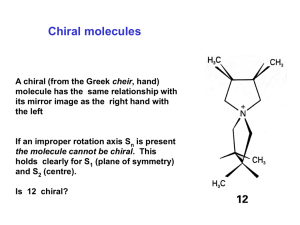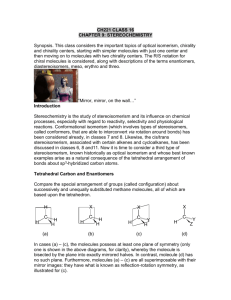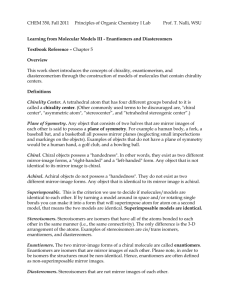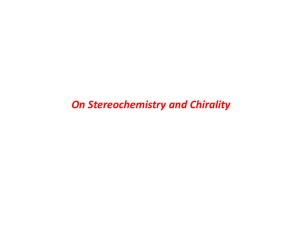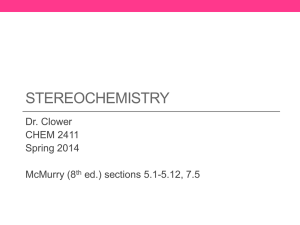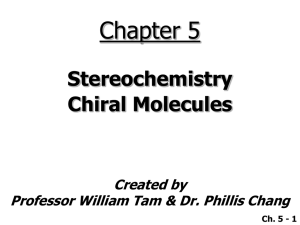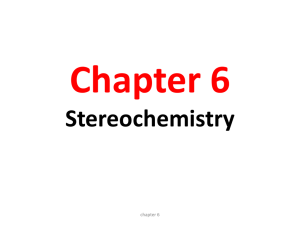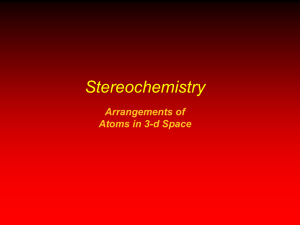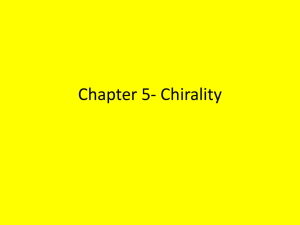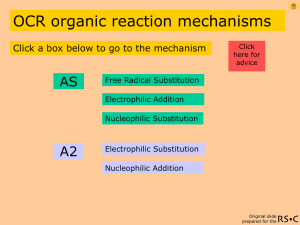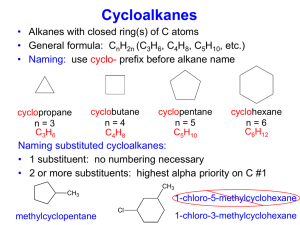Chapter 7
advertisement
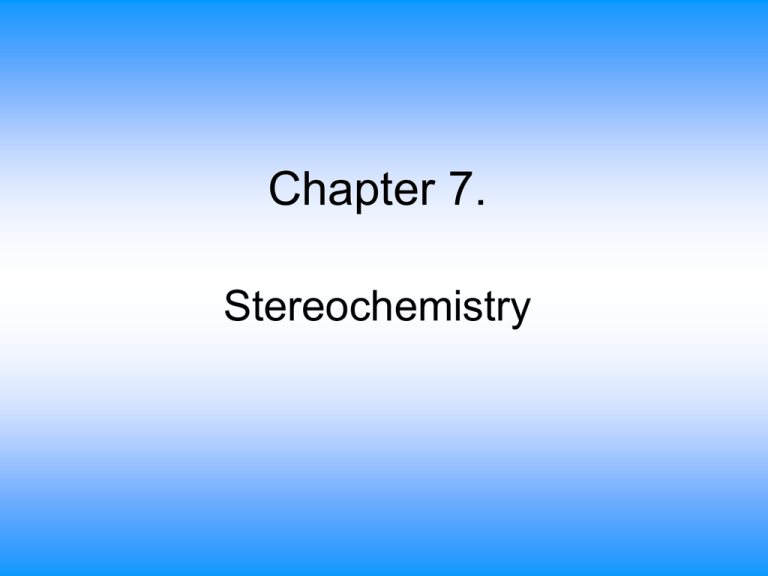
Chapter 7. Stereochemistry Stereochemistry • Some objects are not the same as their mirror images (technically, they have no plane of symmetry) – A right-hand glove is different than a left-hand glove – The property is commonly called “handedness” • Organic molecules (including many drugs) have handedness that results from substitution patterns on sp3 hybridized carbon Enantiomers – Mirror Images • Molecules exist as three-dimensional objects • Some molecules are the same as their mirror image • Some molecules are different than their mirror image – These are stereoisomers called enantiomers 9.1 Enantiomers and the Tetrahedral Carbon • Enantiomers are molecules that are not the same as their mirror image • They are the “same” if the positions of the atoms can coincide on a one-to-one basis (we test if they are superimposable) • This is illustrated by enantiomers of bromochlorofluoromethane Enantiomers of bromochlorofluoromethane 9.2 The Reason for Handedness: Chirality • Molecules that are not superimposable with their mirror images are chiral (have handedness) • A plane of symmetry divides an entire molecule into two pieces that are exact mirror images • A molecule with a plane of symmetry is the same as its mirror image and is said to be achiral (See Figure 9.4 for examples) Chirality • If an object has a plane of symmetry it is necessarily the same as its mirror image • The lack of a plane of symmetry is called “handedness”, chirality • Hands, gloves are prime examples of chiral object – They have a “left” and a “right” version Plane of Symmetry • The plane has the same thing on both sides for the flask • There is no mirror plane for a hand Examples of Enantiomers • Molecules that have one carbon with 4 (count-em 4) different substituents have a nonsuperimposable mirror image – enantiomer Plane of symmetry in chlorodifluoromethane Chiral Carbons • A point in a molecule where four different groups (or atoms) are attached to carbon is called the chiral carbon • There are two nonsuperimposable ways that 4 different different groups (or atoms) can be attached to one carbon atom – If two groups are the same, then there is only one way • A chiral molecule usually has at least one chiral carbon Chirality Centers in Chiral Molecules • Groups are considered “different” if there is anystructural variation (if the groups could not be superimposed if detached, they are different) • In cyclic molecules, we compare by following in each direction in a ring Locate all chiral carbons if any): O CH3CH2CHCH2CH3 CH3 OH CH3 CH3CHCH2CH2CH3 OH CH3 9.3 Optical Activity • Light restricted to pass through a plane is planepolarized • Plane-polarized light that passes through solutions of achiral compounds remains in that plane • Solutions of chiral compounds rotate planepolarized light and the molecules are said to be optically active • Phenomenon discovered by Biot in the early 19th century Optical Activity • Light passes through a plane polarizer • Plane polarized light is rotated in solutions of optically active compounds • Measured with polarimeter • Rotation, in degrees, is [] • Clockwise rotation is called dextrorotatory • Anti-clockwise is levorotatory Measurement of Optical Rotation • A polarimeter measures the rotation of plane-polarized that has passed through a solution • The source passes through a polarizer and then is detected at a second polarizer • The angle between the entrance and exit planes is the optical rotation. Specific Rotation • To have a basis for comparison, define specific rotation, []D for an optically active compound • []D = observed rotation/(pathlength x concentration) = /(l x C) = degrees/(dm x g/mL) 9.4 Pasteur’s Discovery of Enantiomers (1849) • Louis Pasteur discovered that sodium ammonium salts of tartaric acid crystallize into right handed and left handed forms • The optical rotations of equal concentrations of these forms have opposite optical rotations • The solutions contain mirror image isomers, called enantiomers and they crystallized in distinctly different shapes – such an event is rare Relative 3-Dimensional Structure • is the mirror image of Lerythrose • This does not apply in general The original method was a correlation system, classifying related molecules into “families” focused on carbohydrates – Correlate to D- and Lglyceraldehyde – D-erythrose 9.5 Sequence Rules for Specification of Configuration • A general method applies to the configuration at each chiral carbon (instead of to the the whole molecule) • The configuration is specified by the relative positions of all the groups with respect to each other at the chiral carbon • The groups are ranked in an established priority sequence and compared • The relationship of the groups in priority order in space determines the label applied to the configuration, according to a rule Cahn-Ingold-Prelog Priority Rules Sequence Rules (IUPAC) • Assign each group priority according to the CahnIngold-Prelog scheme With the lowest priority group pointing away, look at remaining 3 groups in a plane • Clockwise is designated R (from Latin for “right”) • Counterclockwise is designated S (from Latin word for “left”) R-Configuration at Chirality Center • Lowest priority group is pointed away and direction of higher 3 is clockwise, or right turn Examples of Applying Sequence Rules • If lowest priority is back, clockwise is R and counterclockwise is S – R = Rectus – S = Sinister 9.6 Diastereomers • Molecules with more than one chiral carbon have mirror image stereoisomers that are enantiomers 2R,3R 2S,3S • In addition they can have stereoisomeric forms that are not mirror images, called diastereomers 2R,3S 2S,3R Stereoisomers of 2,3-Dichloropentane CH3CHCHCH2CH3 Cl Cl CH3 CH3 CH3 CH3 H C Cl Cl C H Cl C H H C Cl H C Cl Cl C H H C Cl Cl C H CH2CH3 CH2CH3 CH2CH3 Enantiomers Enantiomers Diastereomers CH2CH3 9.7 Meso Compounds • Tartaric acid has two chiral carbons and two diastereomeric forms • One form is chiral and the other is achiral, but both have two chiral carbons • An achiral compound with chiral carbons is called a meso compound – it has a plane of symmetry • The two structures on the right in the figure are identical so the compound (2R, 3S) is achiral Stereoisomers of 2,3-Dichlorobutane CH3CHCHCH3 Cl Cl CH3 CH3 CH3 CH3 H C Cl _________ Cl C H _________ Cl C H H C Cl H C Cl Cl C H H C Cl Cl C H CH3 CH3 Meso Compound CH3 Enantiomers CH3 Fisher Projections CHO CHO H C OH HO C H H C OH H C OH CH2OH H = OH HO H H OH H OH CH2OH Vertical – Bonds are going away from you Horizontal – Bond are coming toward you Fischer projection formulas of the enantiomers of bromochlorofluoromethane CH3CHCHCH3 Cl Cl CH3 CH3 CH3 CH3 H C Cl Cl C H Cl C H H C Cl H C Cl Cl C H H C Cl Cl C H CH3 CH3 CH3 CH3 CH3 CH3 CH3 CH3 H Cl Cl H Cl H H Cl H Cl Cl H H Cl Cl H CH3 CH3 CH3 CH3 Cholesterol has eight chiral carbons 9.9 Physical Properties of Stereoisomers • Enantiomeric molecules differ in the direction in which they rotate plane polarized but their other common physical properties are the same • Daistereomers have a complete set of different common physical properties 9.11 A Brief Review of Isomerism • The flowchart summarizes the types of isomers we have seen Constitutional Isomers • Different order of connections gives different carbon backbone and/or different functional groups Stereoisomers • Same connections, different spatial arrangement of atoms – Enantiomers (nonsuperimposable mirror images) – Diastereomers (all other stereoisomers) • Includes cis, trans and configurational 9.15 Chirality at Atoms Other Than Carbon • Trivalent nitrogen is tetrahedral • Does not form a chiral nitrogen since it rapidly flips • Also applies to phosphorus but it flips more slowly 9.16 Chirality in Nature • Stereoisomers are readily distinguished by chiral receptors in nature • Properties of drugs depend on stereochemistry • Think of biological recognition as equivalent to 3-point interaction
